High Temperature Tribological Performance of Steel/Copper Friction Pairs Lubricated with a Modified C-WS2-(Fe3O4 + TiN) Nanoadditives in Non-Copper Coated Solid Wires
Abstract
:1. Introduction
2. Materials and Methods
2.1. Materials
2.2. Tribological Tests
2.3. Characterization Methods
3. Results and Discussions
3.1. Dispersion Analysis of Nanoparticles
3.2. Tribological Behavior of Individual and Hybrid Nanoadditives
3.3. Components Surface Morphology and Chemical Composition Analysis of the Copper Worn Surfaces
3.4. Lubrication Mechanisms
4. Conclusions
Author Contributions
Funding
Institutional Review Board Statement
Informed Consent Statement
Data Availability Statement
Conflicts of Interest
References
- Zhang, T.; Li, Z.; Young, F.; Kim, H.J.; Li, H.; Jing, H.; Tillmann, W. Global progress on welding consumables for HSLA steel. ISIJ Int. 2014, 54, 1472–1484. [Google Scholar] [CrossRef] [Green Version]
- Koshiishi, F.; Shimizum, H. High-performance, non-copper-coated solid wire for MAG welding SE wire. Kobelco Technol. Rev. 2001, 24, 60–63. [Google Scholar]
- Sapthagiri, S.; Rao, K.J.; Reddy, K.A.; Prabhakar, C.S. Comparison of mechanical properties on 15CDV6 steel plates by TIG welding with and without copper coated filler wires. Int. J. Adv. Res. Found. 2015, 2, 16–20. [Google Scholar]
- Sivapirakasam, S.P.; Mohan, S.; Kumar, M.S.; Surianarayanan, M. Welding fume reduction by nano-alumina coating on electrodes e towards green welding process. J. Clean. Prod. 2015, 108, 131–144. [Google Scholar] [CrossRef]
- Koh, J.H.; Kim, N.H.; Kim, H.T.; Hwang, Y.H. Effect of the Wear of Contact Tips on the Weld beads made by GMAW Process. J. Korea Acad. Ind. Coop. Soc. 2011, 12, 2019–2024. [Google Scholar]
- Kim, I.G. Effect of wear of contact tips to welding consumable for gas metal arc welding. J. Korean Soc. Manuf. Technol. Eng. 2012, 21, 860–864. [Google Scholar]
- Wesling, V.; Schram, A.; Müller, T.; Treutler, K. Influencing the arc and the mechanical properties of the weld metal in GMA-welding processes by additive elements on the wire electrode surface. IOP Conf. Ser. Mater. Sci. Eng. 2016, 118, 012006. [Google Scholar] [CrossRef] [Green Version]
- Li, Z.X.; Wan, Q.; Li, G.D.; Li, H.; Li, H.J.; Zhang, T.L.; Tillmann, K.W. Lubrication mechanisms of C-MoS2-Fe2O3 (Fe3O4) nano-composite lubricants at the rubbing interfaces of non-copper coated solid wires against the contact tube. Mater. Und Werkst. 2019, 50, 52–63. [Google Scholar] [CrossRef] [Green Version]
- Shimizu, H.; Yokota, Y.; Mizuno, M.; Kurokawa, T. Wear mechanism in contact tube. Sci. Technol. Weld. Join. 2006, 11, 94–105. [Google Scholar] [CrossRef]
- Han, J.H.; Lee, J.S.; Kim, S.H.; Yun, J.O. A study on the improvement of a contact tip for the wire melting rate enhancement. Weld. World 2017, 61, 1181–1187. [Google Scholar] [CrossRef]
- Zheng, D.; Wu, Y.P.; Li, Z.Y.; Cai, Z.B. Tribological properties of WS2/graphene nanocomposites as lubricating oil additives. RSC Adv. 2017, 7, 14060–14068. [Google Scholar] [CrossRef] [Green Version]
- An, V.; Irtegov, Y.; Anisimov, E.; Druzyanova, V.; Burtsev, N.; Khaskelberg, M. Tribological properties of nanolamellar tungsten disulfide doped with zinc oxide nanoparticles. SpringerPlus 2015, 4, 673. [Google Scholar] [CrossRef] [PubMed] [Green Version]
- Gulzar, M.; Masjuki, H.H.; Kalam, M.A.; Varman, M.; Zulkifli, N.W.M.; Mufti, R.A.; Zahid, R. Tribological performance of nanoparticles as lubricating oil additives. J. Nanopart. Res. 2016, 18, 223. [Google Scholar] [CrossRef]
- Uflyand, I.E.; Zhinzhilo, V.A.; Burlakova, V.E. Metal-containing nanomaterials as lubricant additives: State-of-the-art and future development. Friction 2019, 7, 93–116. [Google Scholar] [CrossRef] [Green Version]
- Shahnazar, S.; Bagheri, S.; Hamid, S.B.A. Enhancing lubricant properties by nanoparticle additive. Int. J. Hydrogen Energy 2016, 41, 3153–3170. [Google Scholar] [CrossRef]
- Zhang, Z.J.; Simionesie, D.; Schaschke, C. Graphite and hybrid nanomaterials as lubricant additives. Lubricants 2014, 2, 44–65. [Google Scholar] [CrossRef]
- Kim, S.-T.; Woo, J.-Y.; Lee, Y.-Z. Friction, wear, and scuffing characteristics of marine engine lubricants with nanodiamond particles. Tribol. Trans. 2016, 59, 1098–1103. [Google Scholar] [CrossRef]
- Novak, C.; Kingman, D.; Stern, K.; Zou, Q.; Gara, L. Tribological Properties of Paraffinic Oil with Nanodiamond Particles. Tribol. Trans. 2014, 57, 831–837. [Google Scholar] [CrossRef]
- Wu, H.; Zhao, J.; Cheng, X.; Xia, W.; He, A.; Yun, J.-H.; Huang, S.; Wang, L.; Huang, H.; Jiao, S.; et al. Friction and wear characteristics of TiO2 nano-additive water-based lubricant on ferritic stainless steel. Tribol. Int. 2018, 117, 24–38. [Google Scholar] [CrossRef] [Green Version]
- Moshkovich, A.; Perfilyev, V.; Meshi, L.; Samuha, S.; Cohen, S.; Cohen, H.; Laikhtman, A.; Rapoport, L. Friction, wear and structure of Cu samples in the lubricated steady friction state. Tribol. Int. 2012, 46, 154–160. [Google Scholar] [CrossRef]
- Mao, J.; Chen, G.; Zhao, J.; He, Y.; Luo, J. An investigation on the tribological behaviors of steel/copper and steel/steel friction pairs via lubrication with a graphene additive. Friction 2021, 9, 228–238. [Google Scholar] [CrossRef] [Green Version]
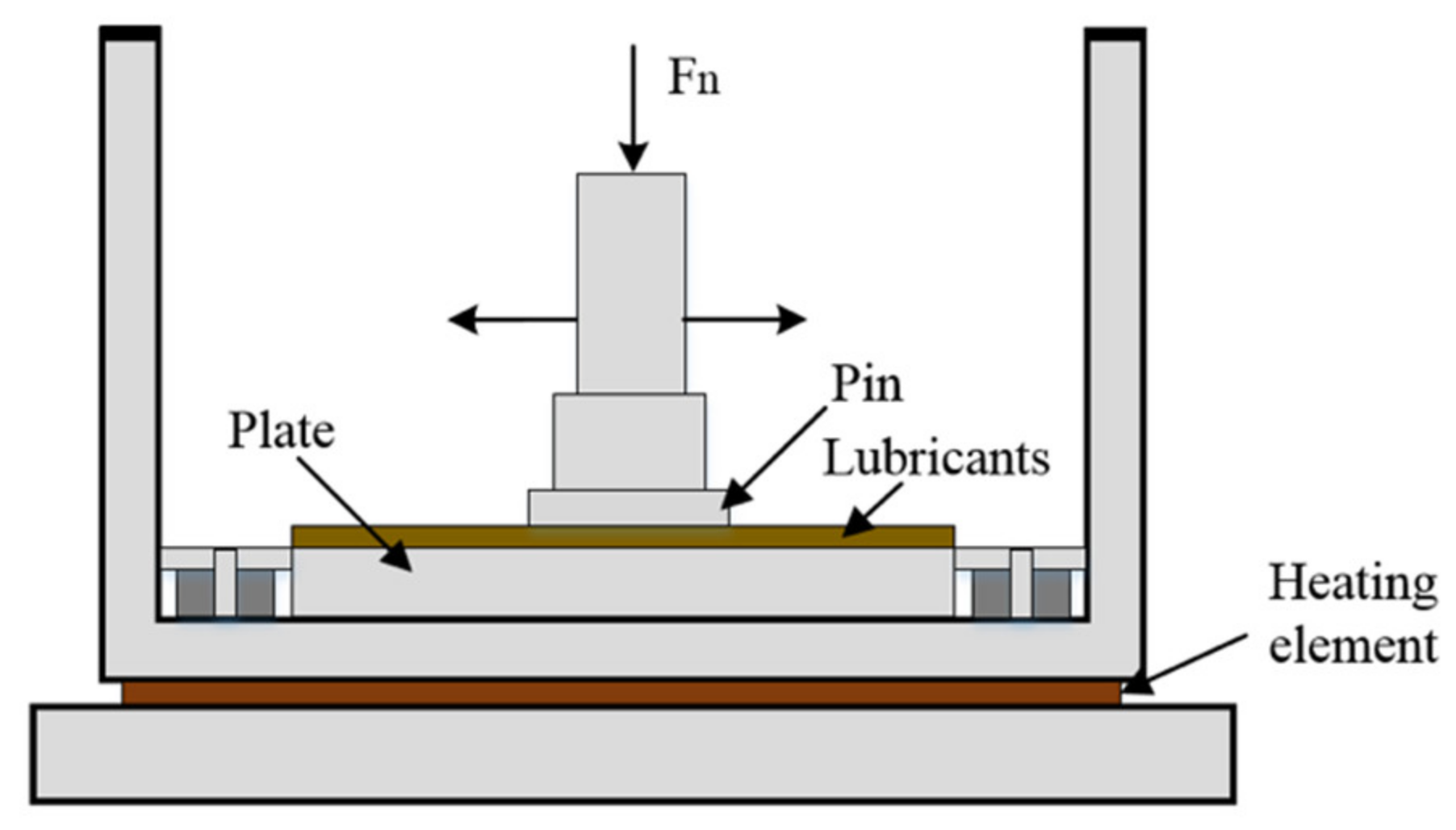
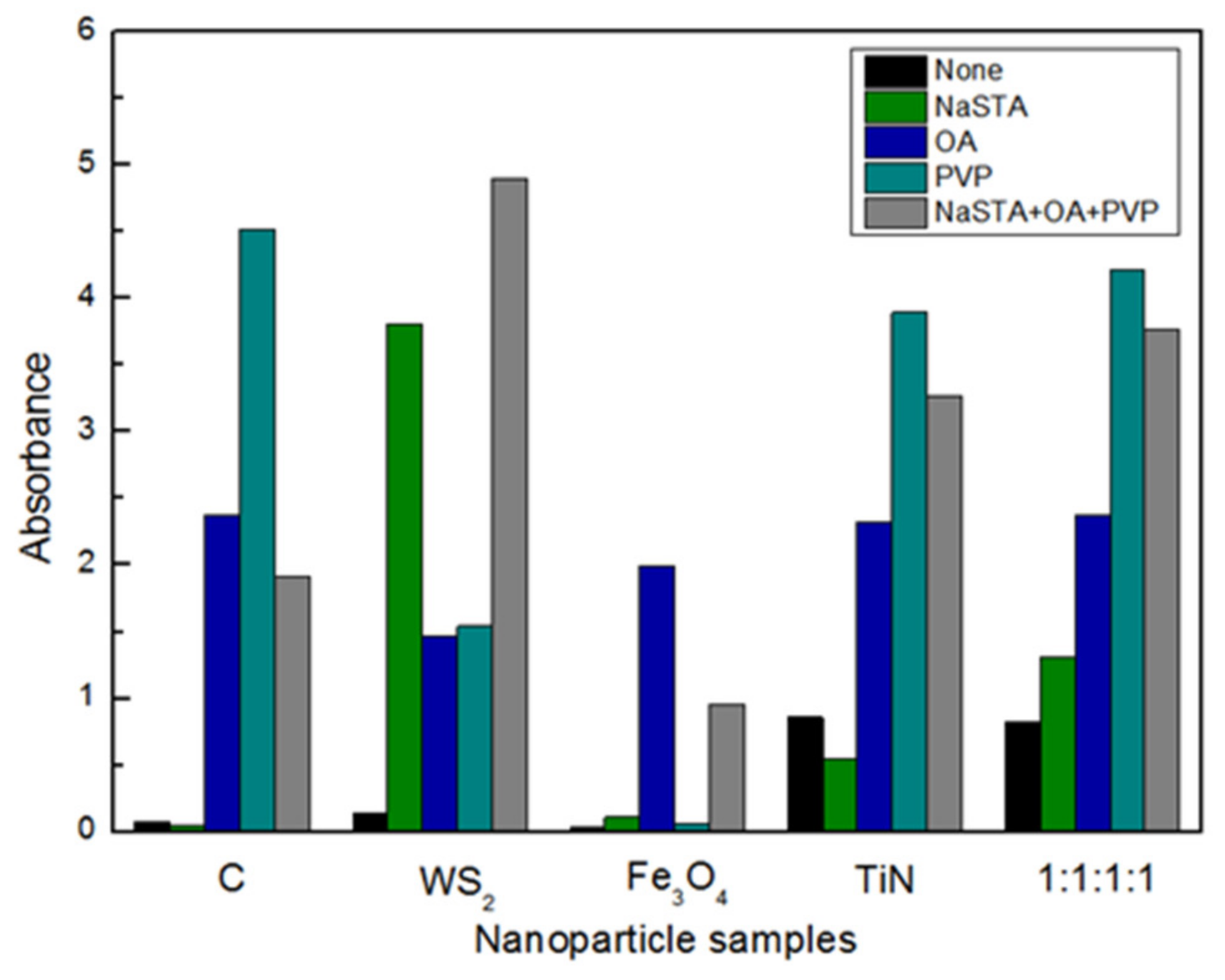
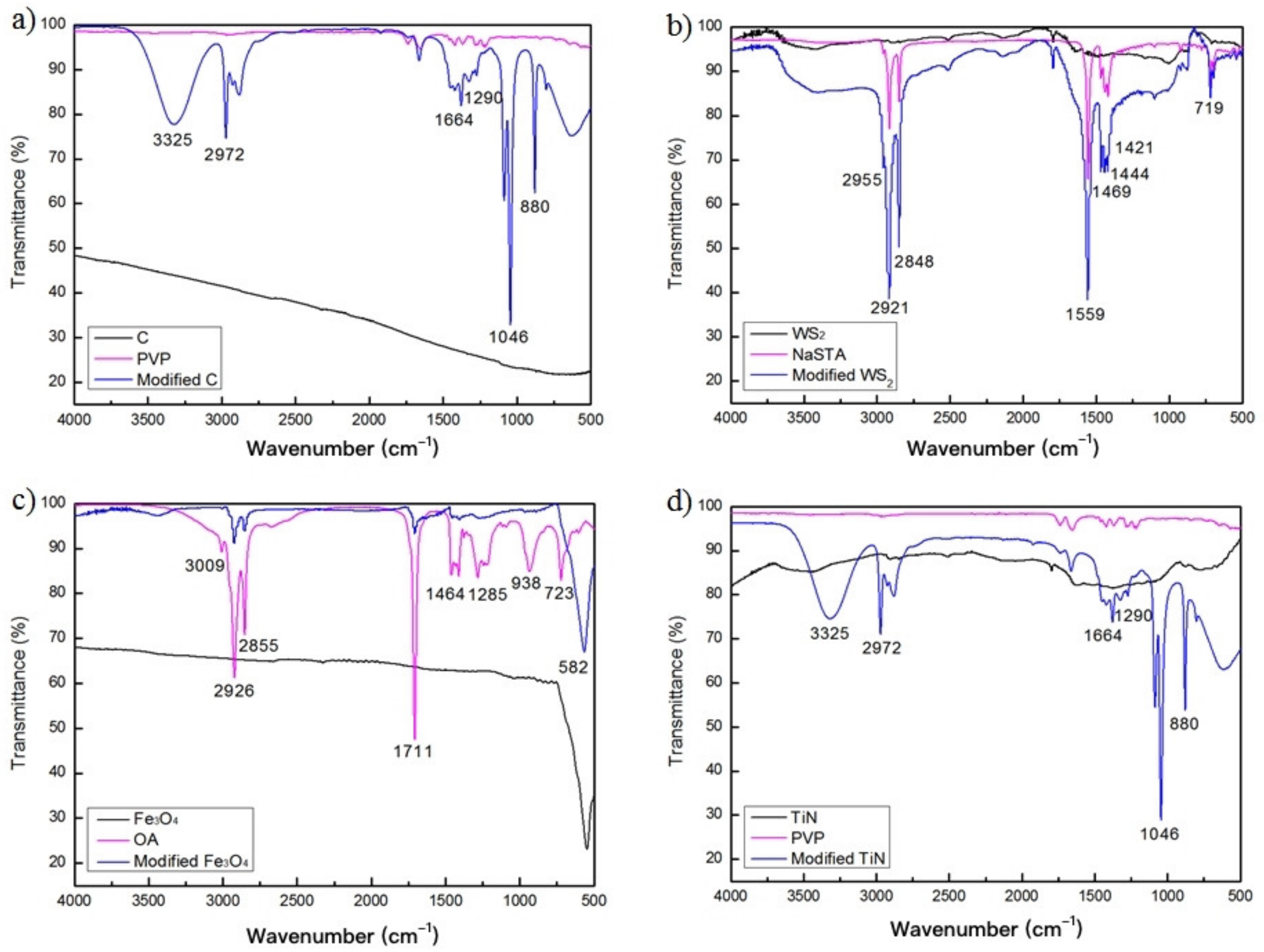

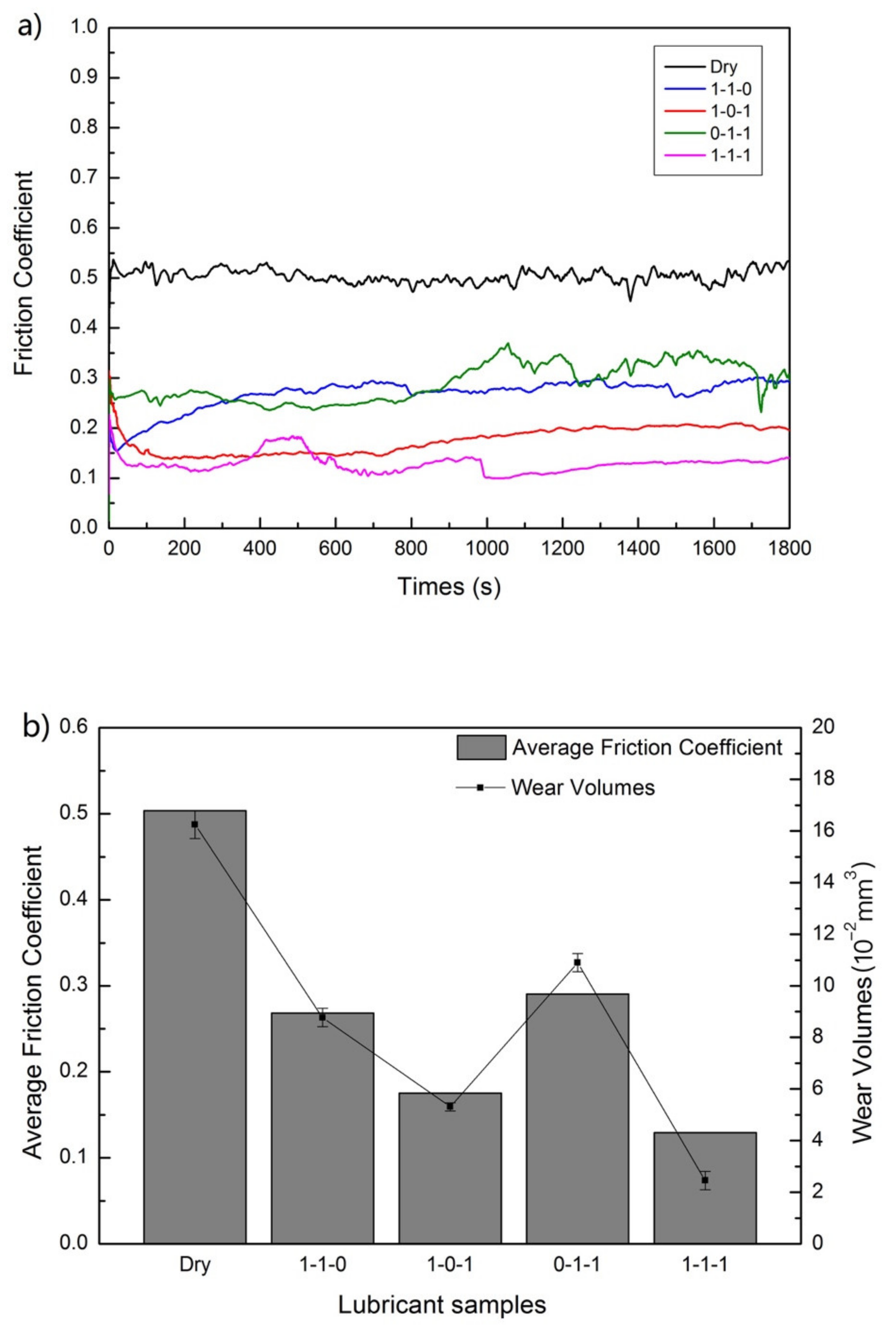

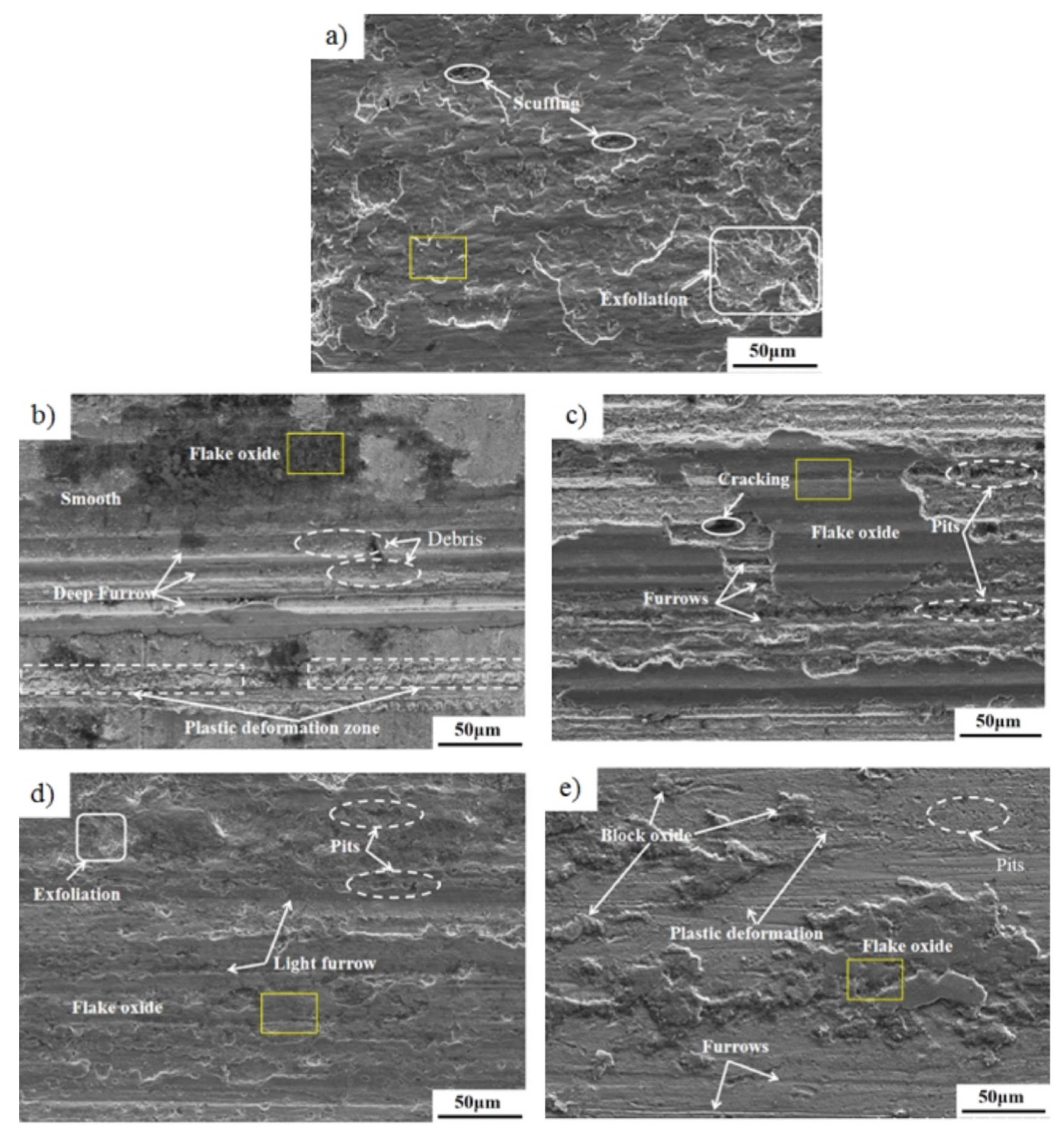
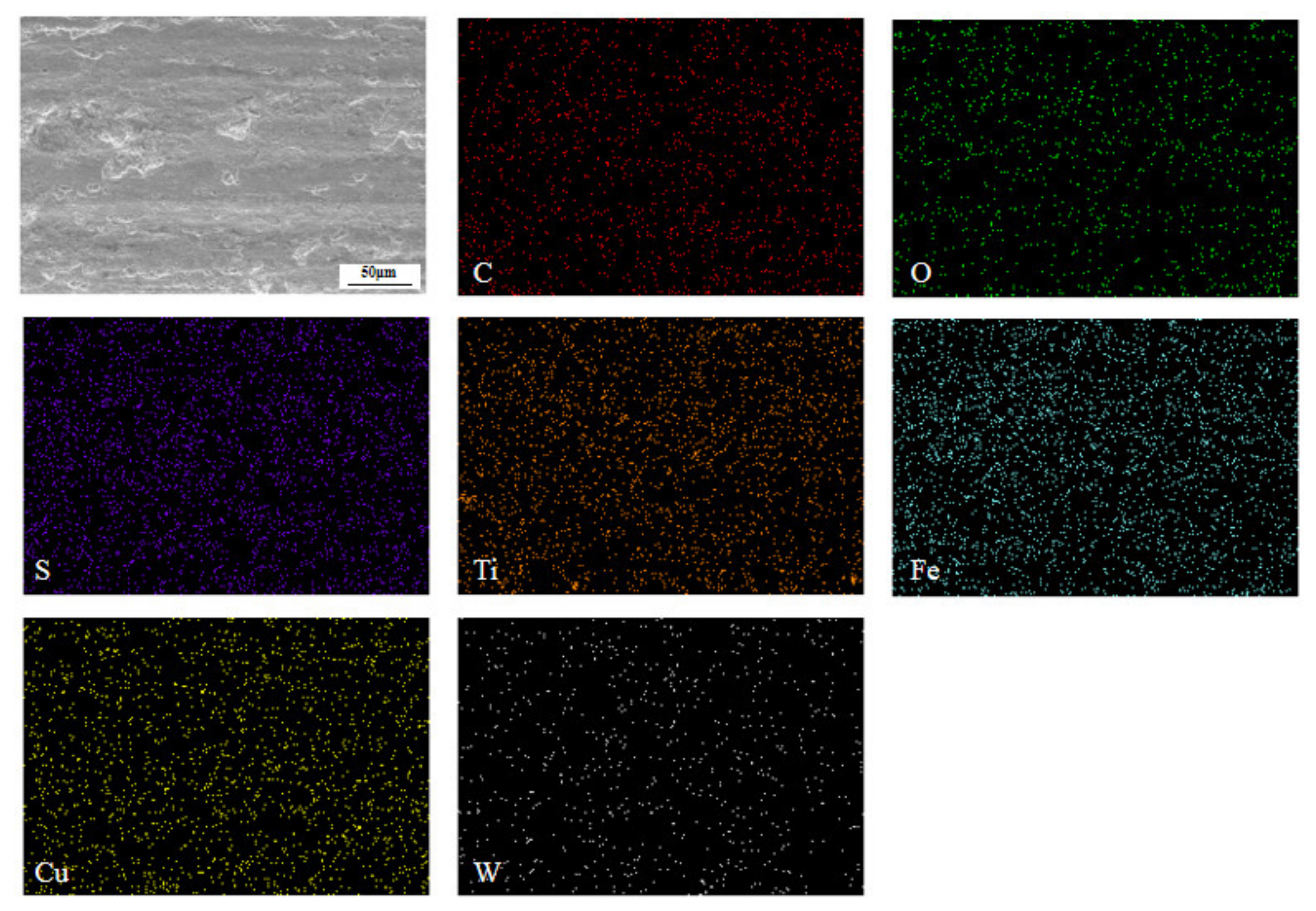
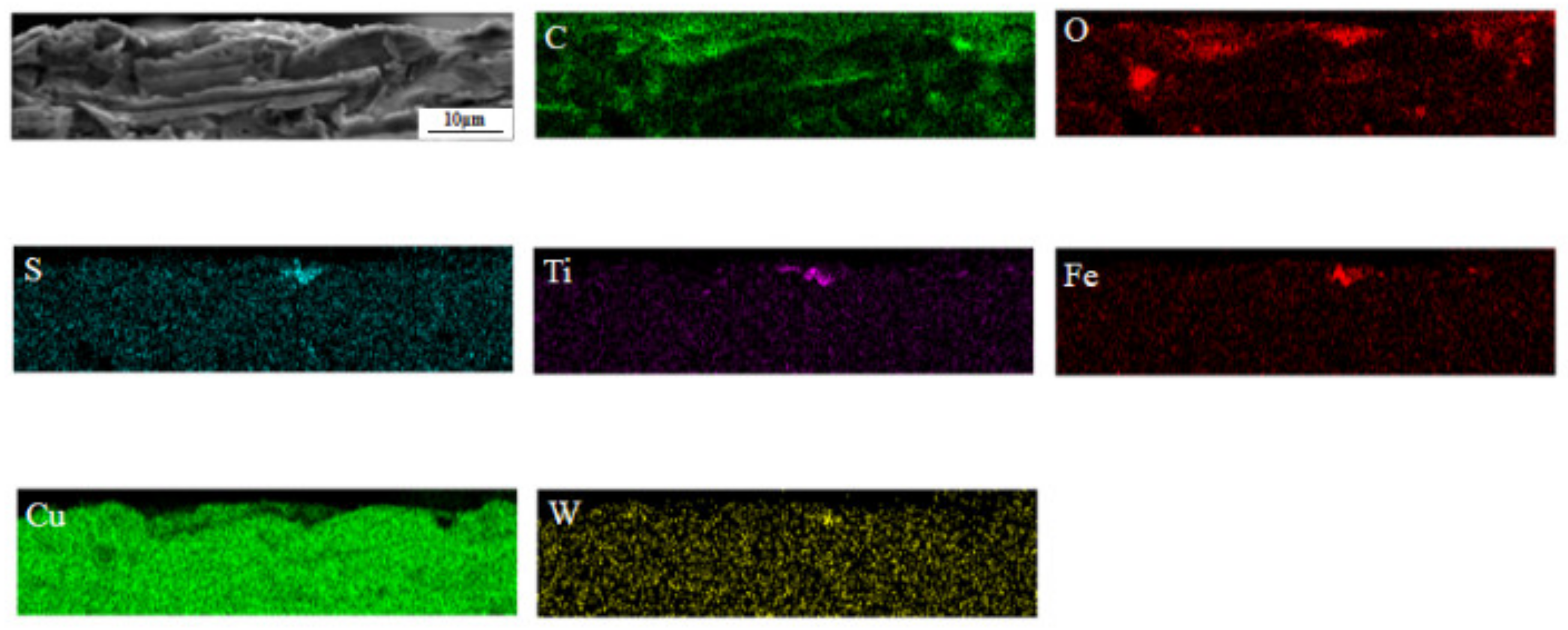
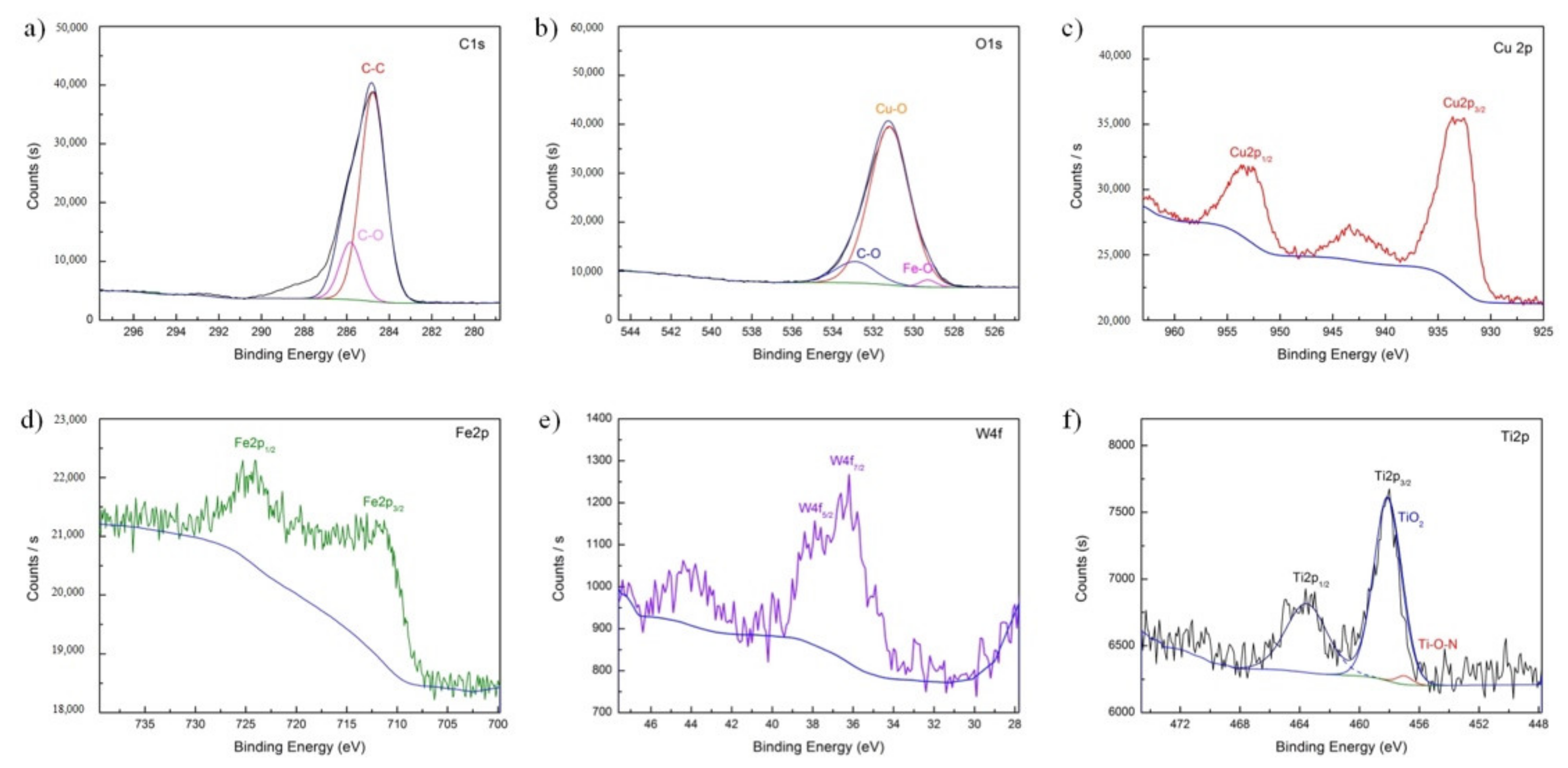

| Lubrication Type | Composition wt.% | ||
|---|---|---|---|
| C | WS2 | Fe3O4 + TiN | |
| 1 | Dry condition | ||
| 2 | 1 | 0 | 0 |
| 3 | 0 | 1 | 0 |
| 4 | 0 | 0 | 1 |
| 5 | 0.5 | 0.5 | 0 |
| 6 | 0.5 | 0 | 0.5 |
| 7 | 0 | 0.5 | 0.5 |
| 8 | 0.333 | 0.333 | 0.333 |
| Materials | Chemical Composition (wt.%) | |||||||
|---|---|---|---|---|---|---|---|---|
| Pin—Q235 | C | Mn | Si | S | P | Fe | ||
| ≤0.17 | ≤1.4 | ≤0.35 | ≤0.035 | ≤0.035 | Bal. | |||
| Plate—Cu-Cr-Zr | Cr | Zr | Fe | Al | Mg | Si | P | Cu |
| 0.1- 0.8 | 0.3- 0.6 | 0.5 | 0.1- 0.25 | 0.1- 0.25 | 0.5 | 0.1 | Bal. | |
Publisher’s Note: MDPI stays neutral with regard to jurisdictional claims in published maps and institutional affiliations. |
© 2022 by the authors. Licensee MDPI, Basel, Switzerland. This article is an open access article distributed under the terms and conditions of the Creative Commons Attribution (CC BY) license (https://creativecommons.org/licenses/by/4.0/).
Share and Cite
Li, H.; Zhu, J.; Chen, Z.; Li, Z.; Meng, B. High Temperature Tribological Performance of Steel/Copper Friction Pairs Lubricated with a Modified C-WS2-(Fe3O4 + TiN) Nanoadditives in Non-Copper Coated Solid Wires. Nanomaterials 2022, 12, 2091. https://doi.org/10.3390/nano12122091
Li H, Zhu J, Chen Z, Li Z, Meng B. High Temperature Tribological Performance of Steel/Copper Friction Pairs Lubricated with a Modified C-WS2-(Fe3O4 + TiN) Nanoadditives in Non-Copper Coated Solid Wires. Nanomaterials. 2022; 12(12):2091. https://doi.org/10.3390/nano12122091
Chicago/Turabian StyleLi, Hong, Jing Zhu, Zisong Chen, Zhuoxin Li, and Bo Meng. 2022. "High Temperature Tribological Performance of Steel/Copper Friction Pairs Lubricated with a Modified C-WS2-(Fe3O4 + TiN) Nanoadditives in Non-Copper Coated Solid Wires" Nanomaterials 12, no. 12: 2091. https://doi.org/10.3390/nano12122091






